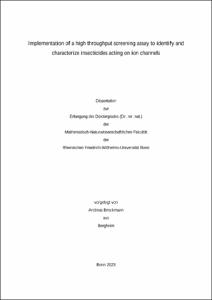Brockmann, Andreas: Implementation of a high throughput screening assay to identify and characterize insecticides acting on ion channels. - Bonn, 2023. - Dissertation, Rheinische Friedrich-Wilhelms-Universität Bonn.
Online-Ausgabe in bonndoc: https://nbn-resolving.org/urn:nbn:de:hbz:5-72033
Online-Ausgabe in bonndoc: https://nbn-resolving.org/urn:nbn:de:hbz:5-72033
@phdthesis{handle:20.500.11811/11123,
urn: https://nbn-resolving.org/urn:nbn:de:hbz:5-72033,
author = {{Andreas Brockmann}},
title = {Implementation of a high throughput screening assay to identify and characterize insecticides acting on ion channels},
school = {Rheinische Friedrich-Wilhelms-Universität Bonn},
year = 2023,
month = nov,
note = {With 800 million people suffering from hunger, new innovative crop protection products are required to ensure food supply and stop hunger. The voltage-sensitive sodium channel (VSSC) was shown to be a safe and effective insecticidal target in over 40 years of intensive use of pyrethroids. Arising pyrethroid-resistances, however, require the development of new resistance-breaking VSSC modulators. For this purpose, a new high throughput screening assay was developed to screen over 1.000.000 compounds. Channelrhodopsin 2 (ChR2), a light-activated ion channel, was implemented to activate the sodium channel. Optimizing light pulse protocols facilitated the identification of weak and state-dependent modulators.
After performing the screen, the potential hits were biochemically characterized. Automated patch clamp technology was used to validate 2000 potential HTS hits. A tailor-made pulse protocol enabled the detection of true VSSC modulators. Subsequently, purified hits and close analogs were characterized using fluorescent and electrophysiological readouts. Two different cell lines were used to identify resistance-breaking potential and selectivity to one human analog. An injection assay monitored potential in vivo efficacy on pest-relevant caterpillars (Spodoptera frugiperda). Finally, one hit class was found, showing the following required properties: high selectivity towards the human channel NaV1.7, resistance-breaking potential and already strong intrinsic in vivo efficacy. Chemical optimization of the hit has started and delivered plausible structure-activity relationships. The in vitro activity was thereby matching the in vivo activity.
In this thesis, mutagenesis studies were implemented to identify the binding site of a new insect-selective VSSC modulator. A couple of different mutations were created to gain a loss of sensitivity towards the modulator by humanizing the insect VSSC. A significant reduction in the response of the compound was observed, narrowing down the binding site to a small area. Further experiments must be performed to elucidate the binding site.
In the last part of my thesis, the exact binding site of two different Slo-channel modulators was identified in cooperation between the Max Planck Institute Dortmund and Bayer. With the data this thesis provides, we were able to characterize the electrophysiological behavior of emodepside and verruculogen. The resolved cryo-EM structure helped to understand their mechanism of action and explained the interaction between both compounds. Through further mutagenesis studies performed at the Slo channel, we gained more profound insights into the mode of action of verruculogen and highlighted the importance of the gating threonine for the Slo channel.},
url = {https://hdl.handle.net/20.500.11811/11123}
}
urn: https://nbn-resolving.org/urn:nbn:de:hbz:5-72033,
author = {{Andreas Brockmann}},
title = {Implementation of a high throughput screening assay to identify and characterize insecticides acting on ion channels},
school = {Rheinische Friedrich-Wilhelms-Universität Bonn},
year = 2023,
month = nov,
note = {With 800 million people suffering from hunger, new innovative crop protection products are required to ensure food supply and stop hunger. The voltage-sensitive sodium channel (VSSC) was shown to be a safe and effective insecticidal target in over 40 years of intensive use of pyrethroids. Arising pyrethroid-resistances, however, require the development of new resistance-breaking VSSC modulators. For this purpose, a new high throughput screening assay was developed to screen over 1.000.000 compounds. Channelrhodopsin 2 (ChR2), a light-activated ion channel, was implemented to activate the sodium channel. Optimizing light pulse protocols facilitated the identification of weak and state-dependent modulators.
After performing the screen, the potential hits were biochemically characterized. Automated patch clamp technology was used to validate 2000 potential HTS hits. A tailor-made pulse protocol enabled the detection of true VSSC modulators. Subsequently, purified hits and close analogs were characterized using fluorescent and electrophysiological readouts. Two different cell lines were used to identify resistance-breaking potential and selectivity to one human analog. An injection assay monitored potential in vivo efficacy on pest-relevant caterpillars (Spodoptera frugiperda). Finally, one hit class was found, showing the following required properties: high selectivity towards the human channel NaV1.7, resistance-breaking potential and already strong intrinsic in vivo efficacy. Chemical optimization of the hit has started and delivered plausible structure-activity relationships. The in vitro activity was thereby matching the in vivo activity.
In this thesis, mutagenesis studies were implemented to identify the binding site of a new insect-selective VSSC modulator. A couple of different mutations were created to gain a loss of sensitivity towards the modulator by humanizing the insect VSSC. A significant reduction in the response of the compound was observed, narrowing down the binding site to a small area. Further experiments must be performed to elucidate the binding site.
In the last part of my thesis, the exact binding site of two different Slo-channel modulators was identified in cooperation between the Max Planck Institute Dortmund and Bayer. With the data this thesis provides, we were able to characterize the electrophysiological behavior of emodepside and verruculogen. The resolved cryo-EM structure helped to understand their mechanism of action and explained the interaction between both compounds. Through further mutagenesis studies performed at the Slo channel, we gained more profound insights into the mode of action of verruculogen and highlighted the importance of the gating threonine for the Slo channel.},
url = {https://hdl.handle.net/20.500.11811/11123}
}






